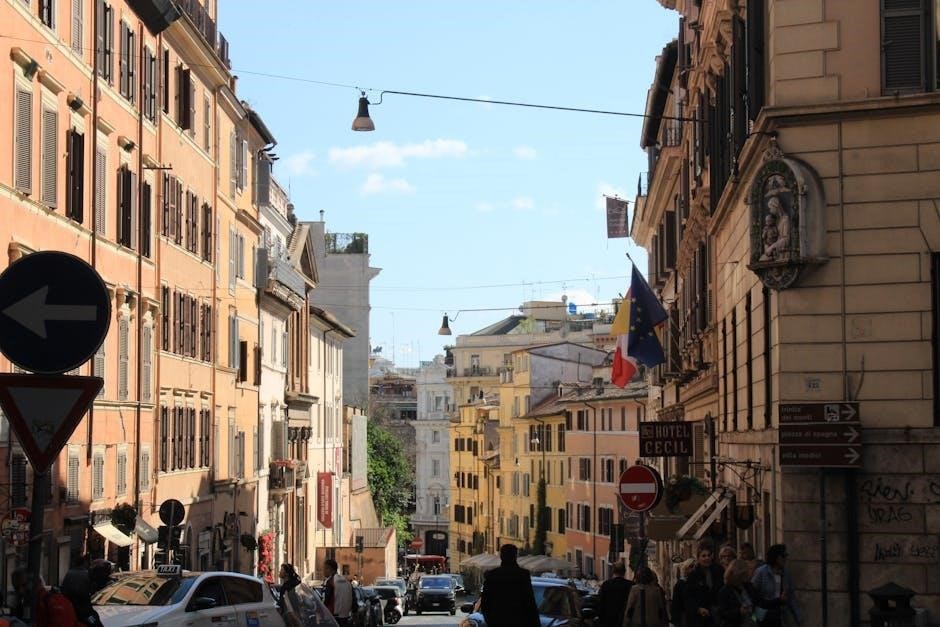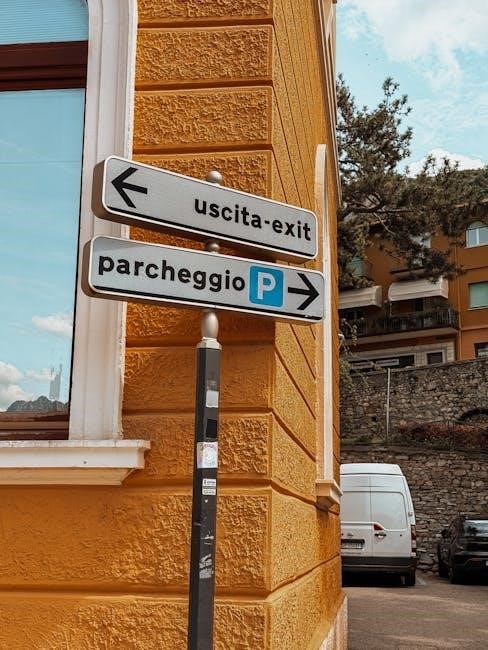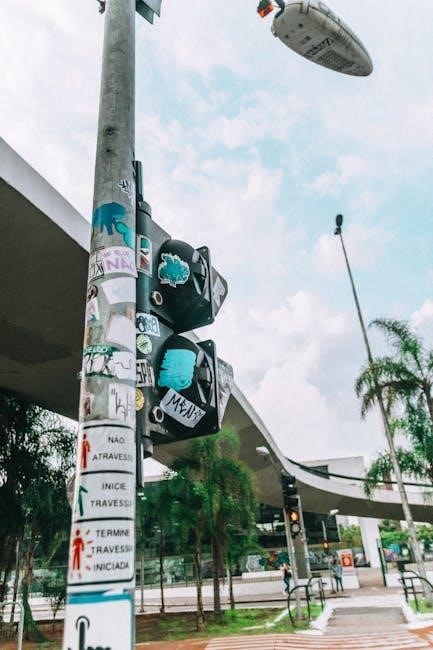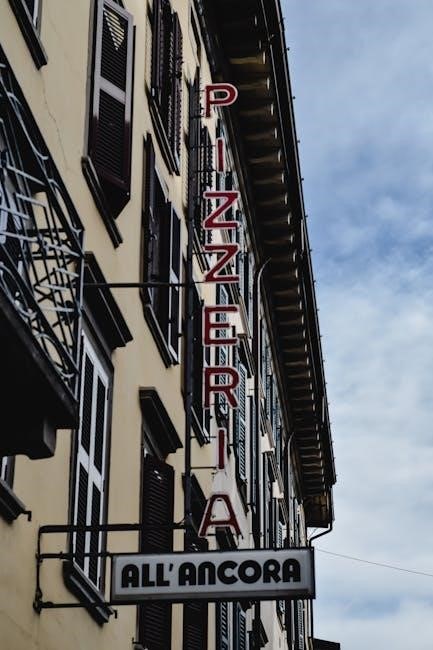Italian traffic signs are categorized into warning, priority, informational, directional, and temporary signs. They feature distinct shapes and colors for quick recognition. PDF guides are available for download, offering a comprehensive overview to aid drivers in understanding and adhering to Italian road regulations, enhancing safety and compliance while driving.
Overview of Italian Traffic Signs
Italian traffic signs are categorized into warning, priority, informational, directional, and temporary signs. Warning signs alert drivers to potential hazards, while priority signs indicate right-of-way rules. Informational signs provide directions or service details, and directional signs guide navigation. Temporary signs address construction or special events. These signs feature standardized shapes and colors for quick recognition. A PDF guide offers a detailed breakdown of all categories, ensuring drivers can understand and comply with Italian traffic laws. This resource is essential for safe and lawful driving in Italy, helping to prevent accidents and ensure smooth traffic flow.
Importance of Understanding Traffic Signs in Italy
Understanding Italian traffic signs is crucial for ensuring road safety, avoiding fines, and navigating efficiently. Ignoring these signs can lead to accidents, penalties, and legal consequences. Clear comprehension helps drivers adhere to speed limits, right-of-way rules, and directional guidance. For tourists and foreign drivers, familiarity with Italian signs is essential to avoid confusion. PDF guides provide detailed explanations, enabling drivers to recognize and interpret signs accurately. This knowledge enhances driving confidence, reduces risks, and ensures compliance with Italys strict traffic laws, making it vital for both locals and visitors to understand these signs thoroughly.
Categories of Italian Traffic Signs
Italian traffic signs are categorized into warning, priority, informational, directional, and temporary signs. A PDF guide provides a detailed overview of each category.
Warning Signs
Warning signs in Italy are triangular with a red border and yellow background, alerting drivers to potential hazards. Examples include curves, intersections, pedestrian crossings, and school zones. These signs often feature symbols like exclamation marks or images of specific hazards. Some warning signs include supplementary plates indicating distances or additional information. They are placed before hazardous areas to allow drivers to react appropriately. Understanding these signs is crucial for safe navigation, as they indicate conditions requiring extra caution. A PDF guide provides detailed visuals and explanations, aiding drivers in recognizing and interpreting these signs effectively while driving in Italy.
Priority Signs
Priority signs in Italy are circular with a blue background and white symbols, indicating right-of-way rules. Common examples include the “Stop” sign (octagon shape) and “Give Way” (inverted triangle). These signs clarify who has precedence at intersections or merging lanes. They are essential for maintaining orderly traffic flow and preventing conflicts. Priority signs are often accompanied by supplementary plates for clarity. Understanding these signs is vital for complying with traffic laws and ensuring smooth transitions at junctions. A PDF guide provides detailed visuals and explanations, helping drivers recognize and interpret priority signs accurately while navigating Italian roads.
Informational Signs
Informational signs in Italy provide essential details to drivers, such as distances, directions, and services. They are typically rectangular and feature white backgrounds with green or blue text. These signs guide drivers to cities, motorways, and tourist attractions, often including arrows and place names. They also indicate service areas, parking, and emergency exits. Informational signs enhance navigation, especially on highways, by offering clear and concise information. A PDF guide is available, providing visuals and explanations to help drivers easily recognize and understand these signs, ensuring efficient travel across Italy’s extensive road network.
Directional Signs
Directional signs in Italy are designed to guide drivers toward specific destinations, such as cities, regions, or motorways. These signs are typically green or white, featuring bold text and arrows to indicate directions. They are strategically placed at junctions and intersections to help drivers navigate efficiently. Green signs are often used for Autostrade (motorways), while white signs provide directions to cities and tourist locations. Directional signs include distances in kilometers and arrows pointing to the correct route. They are complemented by clear typography and color coding for easy recognition. A PDF guide is available for reference, detailing these signs to aid drivers in navigating Italy’s road network effectively.
Temporary Signs
Temporary signs in Italy are crucial for managing traffic during construction, roadwork, or special events. These signs are typically yellow and feature clear symbols or arrows to redirect drivers. They provide essential updates on detours, lane closures, or alternative routes. Their bright colors ensure visibility, especially in low-light conditions. Examples include signs for roadwork, detours, or temporary speed limits. A PDF guide offers detailed visuals and explanations, helping drivers understand these signs and navigate safely. Temporary signs play a vital role in maintaining order and safety on Italian roads during disruptions.
Downloading Italian Traffic Signs PDF
Official sources offer downloadable PDF guides for Italian traffic signs. These comprehensive resources provide clear visuals and explanations, aiding drivers in understanding and adhering to Italian road laws.
Official Sources for PDF Downloads
Official Italian government websites and transportation authorities provide authentic PDF guides for traffic signs. These resources are reliable, ensuring accurate and up-to-date information. They are freely accessible, making it easy for drivers to download and print them. The guides are structured to cover all categories of signs, aiding in comprehension. Using these official sources guarantees adherence to current traffic laws and regulations. They are indispensable for both locals and tourists planning to drive in Italy, offering a clear and detailed reference for safe navigation.
Benefits of Using PDF Guides for Drivers
PDF guides for Italian traffic signs provide a portable and comprehensive resource for drivers. They offer detailed visuals and explanations, aiding in quick understanding of road regulations. These guides are ideal for pre-trip preparation, ensuring drivers are well-informed. They are easily printable, allowing for offline access. By using these guides, drivers can avoid confusion and fines, enhancing safety and compliance. They are particularly beneficial for tourists unfamiliar with Italian traffic laws, offering a clear reference for navigating the country’s roads confidently and responsibly.
History and Evolution of Italian Traffic Signs
Italian traffic signs have evolved historically, adapting to modern needs and EU standards, ensuring clarity and safety for all road users with detailed PDF guides.
Development Over Time
Italian traffic signs have evolved significantly over the decades, with early systems focusing on basic navigation and safety. The 1950s saw standardized signs introduced, aligning with European norms. By the 1990s, Italy adopted EU standards, enhancing clarity and consistency. Modern signs now incorporate digital elements and variable messaging, improving real-time communication. The Italian Highway Code regularly updates signage to reflect changing traffic dynamics. These developments ensure signs remain effective, aiding drivers in navigating Italys diverse road network safely and efficiently. Detailed PDF guides are available, documenting this evolution and current standards.
Adoption of EU Standards
Italy adopted EU traffic sign standards to harmonize with other European countries, enhancing clarity and consistency. This alignment ensures uniformity in design, colors, and symbols, making signs easily recognizable for international drivers. EU standards introduced standardized shapes, such as triangular warning signs and circular prohibitory signs. The adoption also included the use of reflective materials and clear typography for better visibility. This integration facilitates smoother travel across borders and improves overall road safety. PDF guides detail these changes, providing a comprehensive resource for understanding Italy’s EU-compliant traffic signs and their significance for safe driving.

Understanding Italian Traffic Signs
Italian traffic signs are categorized into warning, priority, informational, directional, and temporary signs. They use distinct shapes and colors for quick recognition. PDF guides provide clear visuals and explanations to help drivers understand and adhere to traffic laws, ensuring safety and compliance on Italian roads.
Quick Overview
Italian traffic signs are designed for clarity and safety, categorized into warning, priority, informational, directional, and temporary signs. They use distinct shapes and colors for quick recognition. Warning signs are triangular with yellow backgrounds, while priority signs are circular or diamond-shaped. Informational signs are rectangular, providing directions or services. Directional signs guide travelers to destinations, and temporary signs address construction or detours. PDF guides offer detailed visuals and explanations, helping drivers understand these signs and navigate Italy’s roads confidently. These resources ensure compliance with traffic laws and enhance overall road safety.
Common Shapes and Colors
Italian traffic signs use distinct shapes and colors to convey messages quickly. Warning signs are triangular with yellow backgrounds, while priority signs are circular or diamond-shaped. Informational signs are typically rectangular, often green or blue, providing directions or services. Temporary signs are usually yellow, indicating construction or detours. Complementary signs, like arrows or symbols, enhance clarity. Bright colors ensure visibility, especially at night. This standardized system aids drivers in recognizing and responding to signs efficiently, ensuring safety and adherence to traffic laws. The design reflects European standards, making it intuitive for both locals and tourists to navigate Italy’s roads.
Warning Signs in Detail
Warning signs in Italy are triangular with yellow backgrounds and black symbols, alerting drivers to potential hazards like curves, pedestrian crossings, or falling rocks, ensuring proactive safety measures.
Examples of Warning Signs
Italian warning signs include traffic lights ahead, side wind warnings, and falling rocks. These signs are triangular with a yellow background and black symbols, alerting drivers to potential hazards. Examples like pedestrian crossings, curves, and quayside or riverbank warnings are common. They often feature arrows or pictograms to indicate the nature of the hazard. Additional signs like junction warnings and merging traffic help drivers anticipate and react to changing road conditions, ensuring proactive safety measures are taken while driving in Italy.
Interpreting Warning Signs
Warning signs in Italy are designed to alert drivers to potential hazards ahead. These signs are triangular, with a yellow background and black symbols or text, making them easily recognizable. They indicate dangers such as traffic lights ahead, side wind warnings, or falling rocks. Drivers should interpret these signs as signals to exercise extra caution. For example, a pedestrian crossing warning signifies the need to slow down, while a curve ahead sign suggests reducing speed to maintain control. These signs are essential for proactive driving and adherence to traffic laws.
Understanding warning signs ensures safer navigation of Italys roads. They are standardized to provide clear, instantaneous communication, helping drivers anticipate and respond to hazards effectively. By interpreting these signs correctly, motorists can avoid accidents and fines, contributing to a safer driving environment.

Priority Signs in Detail
Priority signs in Italy, such as Stop and Yield, regulate traffic flow and prevent accidents. They are standardized, following EU norms, ensuring consistency and clear communication to drivers.
Examples of Priority Signs
Priorità signs in Italy include the Stop sign, Yield (Give Way), and Right-of-Way indicators. The Stop sign is octagonal with a red background and white text. Yield signs are triangular, pointing downward, indicating drivers should slow down. Priority Road signs, often rectangular with a blue background, denote the main road. These signs are standardized, following EU norms, and are essential for maintaining orderly traffic flow. They are placed at intersections, roundabouts, and merging lanes to ensure drivers know when to yield or stop, preventing accidents and congestion.
Interpreting Priority Signs
Priority signs in Italy indicate which driver has the right-of-way. The Stop sign requires drivers to come to a complete halt before proceeding. The Yield sign (Give Way) means drivers must slow down and be prepared to stop if necessary. Priority Road signs, often blue, signal that traffic on the main road has the right-of-way. These signs are designed to be universally understood, using shapes and colors to convey their message. Ignoring priority signs can lead to fines and accidents, making it crucial for drivers to recognize and obey them to ensure smooth traffic flow and safety on Italian roads.
Informational Signs in Detail
Informational signs provide crucial guidance, such as directions, distances, and services. They often feature symbols, text, or arrows to help drivers navigate efficiently. These signs ensure clarity and safety, aiding in informed decision-making while driving in Italy.
Examples of Informational Signs
Examples of informational signs include green signs on highways indicating directions to major cities, white signs showing distances to towns, and blue signs for tourist attractions. Brown signs highlight cultural or historical sites, while yellow signs indicate service areas like restaurants or gas stations. These signs are designed with clear symbols, text, and arrows to guide drivers efficiently. They are essential for navigation, especially for tourists unfamiliar with local routes. By providing detailed information, these signs ensure safe and informed travel, complementing the comprehensive guides available in PDF formats for drivers in Italy.
Interpreting Informational Signs
Interpreting informational signs in Italy is straightforward due to their clear and standardized design. Green signs on highways indicate directions to major cities and Autostrade, while white signs display distances and names of towns. Blue signs point to service areas like restaurants and gas stations, and brown signs highlight cultural or historical sites. These signs use a combination of text, symbols, and arrows to guide drivers effectively. Their placement and bright colors ensure visibility, making navigation easier, especially for tourists. Understanding these signs is crucial for seamless travel across Italy’s diverse regions and roadways.
Directional Signs in Detail
Italian directional signs guide drivers with clear visuals and text, indicating routes to cities, Autostrade, and services. Green signs mark highways, while white signs detail towns and distances.
Examples of Directional Signs
Directional signs in Italy guide drivers to cities, Autostrade, and services. Green signs indicate highways, displaying major destinations and distances. White signs provide detailed directions to towns, regional attractions, and services. Arrows and symbols clarify routes, while provincial and regional signs mark administrative boundaries. Tourist information signs highlight cultural or natural landmarks. Service area signs direct drivers to rest stops, gas stations, and parking. These signs are designed for clarity and visibility, ensuring smooth navigation across Italy’s diverse road network.
Interpreting Directional Signs
Directional signs in Italy are designed for clarity and ease of navigation. Green signs on highways indicate major destinations and distances, while white signs provide detailed directions to towns and regional attractions. Arrows and symbols guide drivers through complex junctions, ensuring smooth transitions. These signs are strategically placed to allow ample reaction time, especially on high-speed roads. Text and graphics are used to convey information quickly, helping drivers make informed decisions. By understanding these signs, travelers can efficiently navigate Italy’s road network, whether on Autostrade or regional routes.

Temporary Signs in Detail
Temporary signs in Italy are yellow, indicating detours, construction zones, or alternate routes due to roadwork. They help drivers navigate safely around temporary conditions, ensuring smooth traffic flow.
Examples of Temporary Signs
Temporary signs in Italy are typically yellow and include detour arrows, construction zone indicators, and lane closure signs. These signs often feature directional arrows or text like “Divieto di Transito” to guide drivers around roadwork or incidents. Examples include signs for alternate routes, pedestrian detours, or temporary speed reductions. They may also indicate road closures or one-way traffic due to maintenance; These signs are essential for maintaining safety and traffic flow during temporary disruptions, ensuring drivers can navigate smoothly around affected areas while adhering to the posted restrictions.
Interpreting Temporary Signs
Temporary signs in Italy are designed to provide immediate guidance during roadwork or unexpected conditions. Their bright yellow color ensures high visibility, while clear symbols or text convey essential instructions. Drivers should interpret these signs as indicators of necessary actions, such as reducing speed, merging lanes, or following detour routes. Temporary signs often include arrows or pictograms to quickly communicate changes in traffic flow. It is crucial to adhere to these signs to ensure safety and compliance, as they are placed to mitigate risks associated with temporary disruptions. Understanding these signs requires attention to their placement and content, as they are vital for navigating dynamic road conditions effectively.

Speed Limits and Regulations
Italian traffic signs clearly indicate speed limits, with maximums of 130 km/h on motorways, 110 km/h on highways, 90 km/h outside urban areas, and 50 km/h in cities. In rain, Autostrada limits drop by 20 km/h.
Maximum Speed Limits in Italy
Maximum speed limits in Italy are clearly indicated by road signs, with specific restrictions for different road types. Motorways have a maximum limit of 130 km/h, while non-motorway highways are restricted to 110 km/h. Outside urban areas, the limit is 90 km/h, and within urban zones, it drops to 50 km/h. These limits are enforced under the Italian Highway Code to ensure road safety and efficient traffic flow. In adverse weather conditions, such as rain, speed limits on faster roads like the Autostrada automatically decrease by 20 km/h, making driver vigilance essential. These regulations are designed to balance safety and efficiency across Italy’s diverse road network.
Variable Speed Limits
Variable speed limits in Italy are displayed on electronic panels above roads and adjusted based on real-time conditions. These include traffic congestion, weather, or accidents, overriding standard limits. During heavy rain or fog, limits may drop to 60 km/h. Drivers must be vigilant as these limits can change frequently. Ignoring variable speed limits can result in fines. The system, managed by the Italian Highway Code, aims to improve traffic flow and safety by adapting to changing conditions. This dynamic approach ensures efficient and safe travel across Italy’s roads, balancing safety and traffic management effectively.

Directional and Informational Signs on Highways
Green signs on Italian highways guide drivers to Autostrade, while white signs provide directions to cities, regions, and tourist locations, including distances and arrows for clear navigation.

Examples of Highway Signs
Highway signs in Italy are designed to provide clear guidance to drivers. Green signs indicate Autostrade routes, such as “A1 ౼ Milano Napoli,” while white signs display city names like “Firenze” or “Roma.” Blue signs are used for non-motorway highways, and brown signs highlight cultural or tourist attractions. Additionally, electronic signs display variable speed limits and real-time traffic updates. Directional arrows and distance markers are also common, ensuring drivers can navigate efficiently. These signs are standardized, making it easier for both locals and tourists to follow directions and reach their destinations safely.
Interpreting Highway Signs
Highway signs in Italy are standardized to ensure clarity and ease of understanding. Green signs indicate motorway routes, while blue signs mark non-motorway highways. White signs provide directions to cities, and brown signs highlight cultural attractions. Electronic signs display real-time updates, such as variable speed limits, ensuring drivers adapt to changing conditions. Directional arrows and distance markers guide motorists seamlessly. The consistent use of shapes, colors, and text makes these signs intuitive, even for international drivers. Understanding these signs is crucial for safe and efficient navigation on Italy’s highways, reducing confusion and enhancing overall driving safety.

Signs Indicating Provinces, Regions, and Cities
Italian signs indicating provinces, regions, and cities are white with clear lettering, displaying names and distances. They are placed at junctions and along highways, aiding navigation.
Examples of Geographic Signs
Geographic signs in Italy are designed to clearly indicate provincial, regional, and city boundaries. These signs typically feature a white background with black lettering, displaying the name of the location and often accompanied by directional arrows. Provincial boundary signs mark the entry into a new province, while regional signs denote larger administrative areas. City signs guide drivers toward urban centers, often including distances in kilometers and directional indicators. These signs are strategically placed at key junctions and along highways to assist travelers in navigating Italy’s diverse regions effectively.
Additionally, some geographic signs provide information about upcoming cities or regions, helping drivers plan their routes. These signs are essential for both locals and tourists, ensuring seamless navigation across Italy’s extensive road network. They complement directional signs, offering vital geographic context that enhances the driving experience.
Interpreting Geographic Signs
Geographic signs in Italy are designed to provide clear and concise information about locations, helping drivers navigate the country’s diverse regions. These signs typically feature a white background with black lettering, indicating the names of provinces, regions, or cities. Directional arrows and distances in kilometers are often included to guide travelers effectively. The signs are strategically placed at key junctions and along highways, ensuring drivers can easily identify their location and plan their route. By understanding these signs, drivers can seamlessly transition between regions and cities, enhancing their overall navigation experience in Italy.

Fines for Ignoring Traffic Signs
Fines for ignoring Italian traffic signs range from 41 to 168 Euros, with penalties increasing for severe offenses. Non-compliance can lead to license points being deducted, ensuring road safety adherence.
Penalties for Non-Compliance
Penalties for ignoring Italian traffic signs can result in fines ranging from 41 to 168 Euros, depending on the severity of the offense. Repeat violations may lead to the suspension of a driver’s license, with penalties escalating for more serious infractions. Non-compliance not only risks financial consequences but also endangers road safety. Authorities enforce these measures strictly to maintain traffic order and reduce accidents. Adhering to traffic signs is crucial for avoiding legal repercussions and ensuring safe driving practices across Italy’s diverse road network.
Importance of Adherence
Adhering to Italian traffic signs is crucial for ensuring road safety, maintaining order, and facilitating smooth traffic flow. These signs provide essential guidance to prevent accidents, reduce congestion, and enhance overall driving efficiency. Ignoring traffic signs can lead to dangerous situations, endangering both drivers and pedestrians. Compliance with traffic regulations contributes to a safer environment for all road users. By following the instructions provided by Italian traffic signs, drivers can navigate confidently, avoid potential hazards, and contribute to a more orderly and secure road network across Italy.

Resources and References
Official PDF guides and the Italian Highway Code are essential resources for understanding traffic signs. These documents provide detailed insights, ensuring safe and compliant driving in Italy.
Recommended PDF Guides
Official PDF guides provide a comprehensive overview of Italian traffic signs, categorizing them into warning, priority, informational, directional, and temporary signs. These guides include detailed visuals and explanations, making them indispensable for drivers. They cover essential topics such as speed limits, directional signals, and temporary roadworks. The PDF booklets are designed for quick reference, ensuring drivers can recognize and interpret signs effortlessly. Available from official sources, they are a valuable resource for both locals and tourists, promoting safe and compliant driving across Italy.
Official Italian Highway Code
The Official Italian Highway Code is a fundamental resource for understanding Italian traffic signs and road regulations. It outlines the legal framework governing road usage, including penalties for non-compliance. The Highway Code establishes speed limits, right-of-way rules, and specific ZTL (Limited Traffic Zones). It also details the standardized design of traffic signs, ensuring consistency nationwide. Available as a downloadable PDF, it serves as a crucial reference for drivers, offering insights into safe driving practices and legal obligations. Adhering to its guidelines is essential for avoiding fines and maintaining road safety in Italy.
